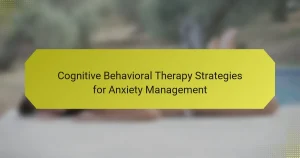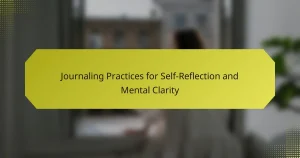Mindfulness techniques can significantly reduce stress and enhance emotional balance. Key practices include mindful breathing, body scanning, and guided meditation. Tailored methods address specific stressors, while unique approaches like sound baths and forest bathing offer additional pathways to emotional equilibrium. Understanding common pitfalls and incorporating expert insights can further optimize mindfulness practice for lasting benefits.
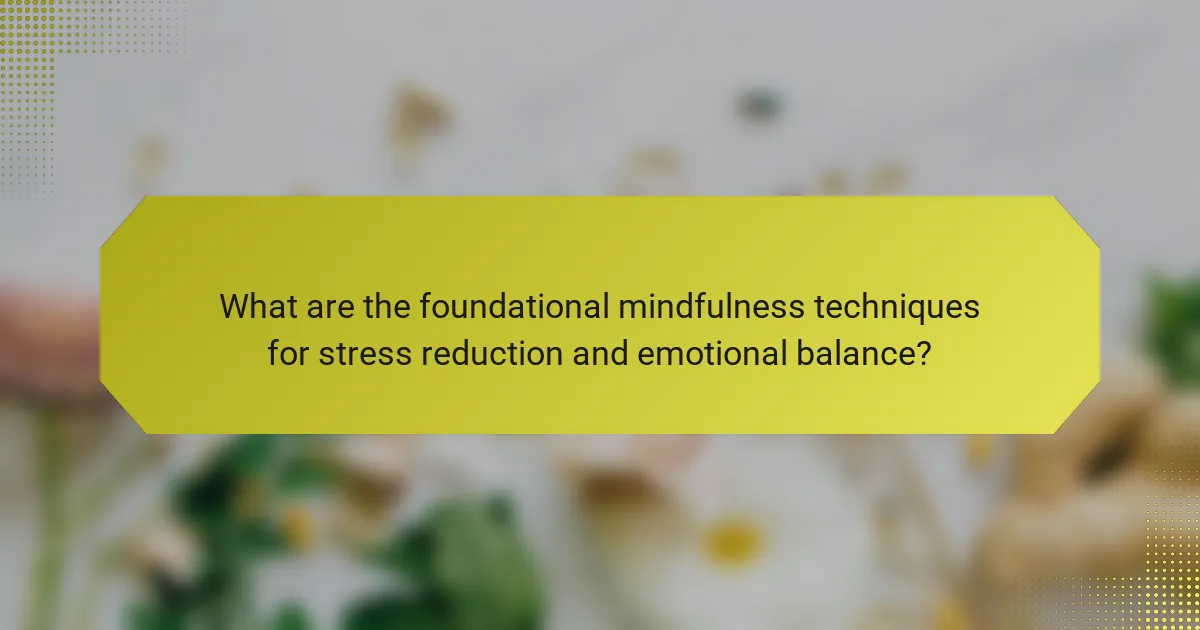
What are the foundational mindfulness techniques for stress reduction and emotional balance?
Mindfulness techniques for stress reduction and emotional balance include practices like meditation, deep breathing, and body scanning. These methods enhance self-awareness and promote relaxation, leading to improved emotional regulation. Regular practice can significantly lower stress levels and increase overall well-being.
Key techniques are:
1. Mindful Breathing: Focus on your breath to anchor yourself in the present moment.
2. Body Scan: Pay attention to physical sensations in each part of your body, promoting relaxation.
3. Guided Meditation: Use audio or video resources to facilitate mindfulness practice.
4. Mindful Eating: Savor each bite and focus on the taste, texture, and aroma of food.
Implementing these techniques can lead to lasting emotional balance and resilience against stress.
How does mindfulness impact stress levels?
Mindfulness techniques significantly reduce stress levels by promoting relaxation and emotional balance. Practices like meditation, deep breathing, and body scanning enhance awareness, allowing individuals to manage stress more effectively. Research indicates that mindfulness can decrease cortisol levels, the hormone associated with stress. Regular mindfulness practice fosters resilience, improving overall mental health and well-being.
What role does emotional balance play in mindfulness practices?
Emotional balance is essential in mindfulness practices as it enhances stress reduction and overall well-being. Mindfulness techniques cultivate awareness and acceptance of emotions, promoting a stable mental state. This balance allows individuals to respond to stressors with clarity rather than reactivity. Regular practice can lead to improved emotional regulation and resilience, fostering a healthier mindset.
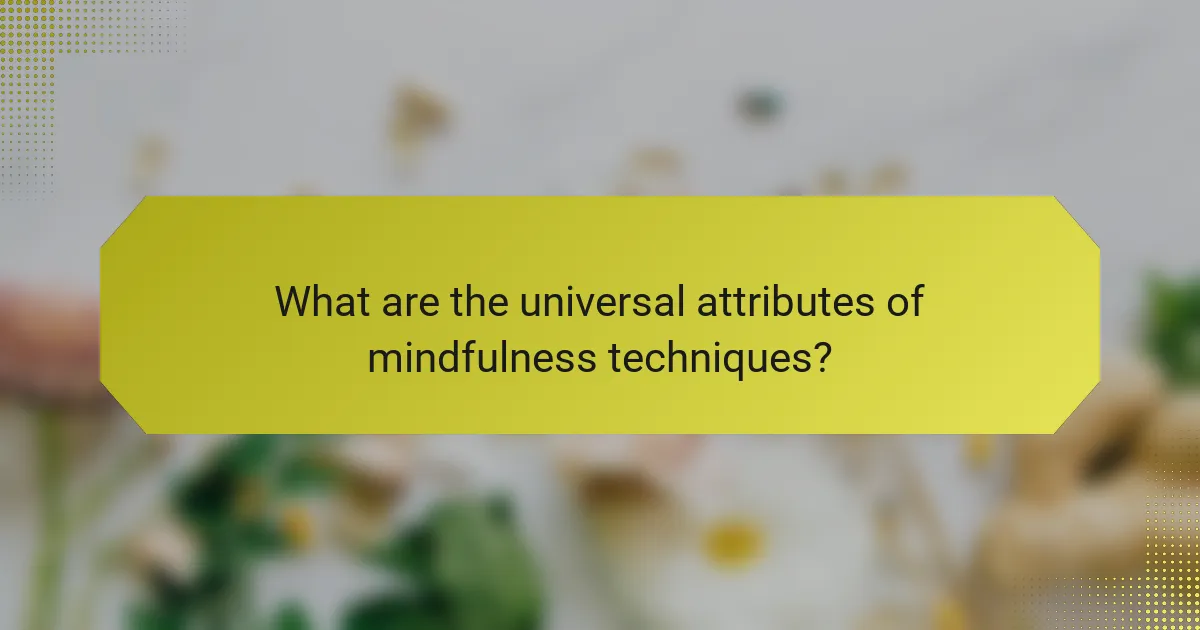
What are the universal attributes of mindfulness techniques?
Mindfulness techniques universally promote awareness and presence, aiding stress reduction and emotional balance. Key attributes include breath awareness, body scan, and mindful movement. These techniques enhance emotional regulation, improve focus, and foster self-compassion. Regular practice can lead to long-term benefits, such as reduced anxiety and improved overall well-being.
How can breath awareness be utilized for stress relief?
Breath awareness can effectively relieve stress by promoting relaxation and enhancing emotional balance. Focusing on breath helps anchor the mind, reducing anxiety and fostering a sense of calm. This technique encourages mindfulness, allowing individuals to observe their thoughts without judgment. By practicing breath awareness regularly, one can develop resilience against stressors, improving overall mental well-being.
What are the benefits of body scanning in emotional regulation?
Body scanning enhances emotional regulation by promoting awareness of bodily sensations. This technique fosters mindfulness, allowing individuals to identify and process emotions effectively. Research indicates that regular practice can reduce anxiety and improve emotional resilience. It encourages a deeper connection to the present moment, facilitating healthier responses to stressors.
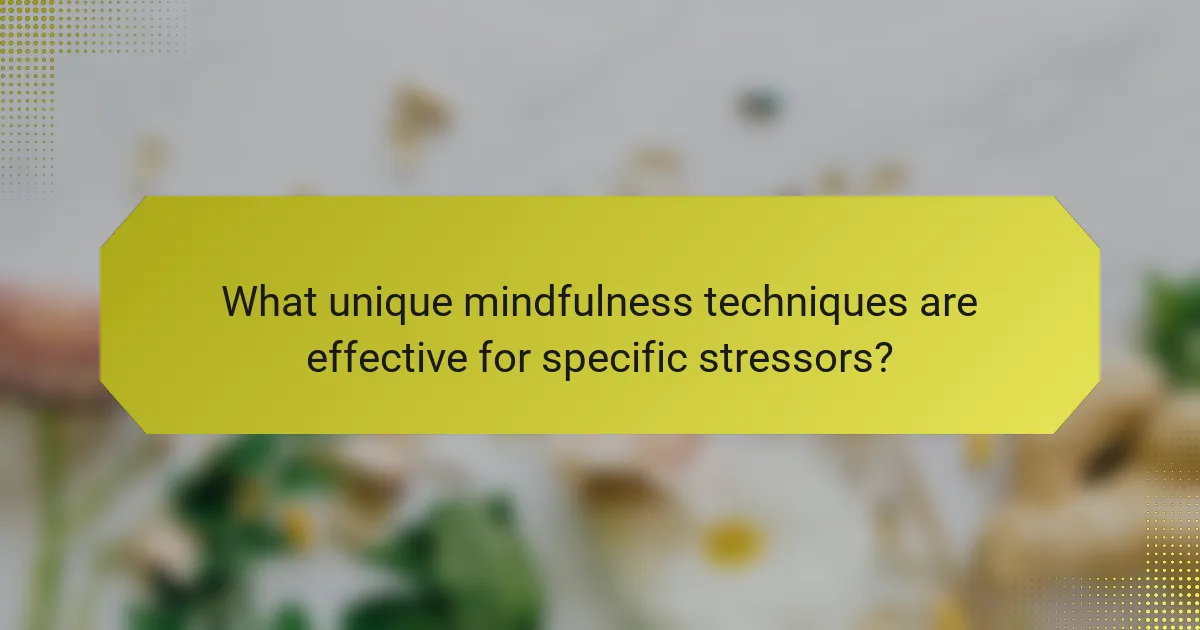
What unique mindfulness techniques are effective for specific stressors?
Mindfulness techniques tailored to specific stressors can significantly enhance emotional balance. Techniques such as body scan meditation effectively address physical stress, while gratitude journaling can mitigate anxiety by fostering positive thoughts. Visualization exercises are beneficial for performance-related stress, helping individuals imagine success scenarios. For interpersonal conflicts, mindful communication techniques promote empathy and reduce tension. Lastly, nature immersion mindfulness can alleviate stress from urban environments by reconnecting individuals with natural surroundings.
How can mindful walking enhance emotional well-being?
Mindful walking enhances emotional well-being by promoting present-moment awareness and reducing stress. This practice encourages individuals to focus on their surroundings, fostering a sense of connection and calm. Research indicates that engaging in mindful walking can lower anxiety levels and improve mood. It also serves as a unique attribute of mindfulness techniques, providing a simple yet effective way to achieve emotional balance. As a result, incorporating mindful walking into daily routines can significantly enhance overall mental health.
What is the role of gratitude journaling in mindfulness?
Gratitude journaling enhances mindfulness by fostering awareness of positive experiences. This practice encourages individuals to reflect on daily moments of gratitude, which can lead to reduced stress and improved emotional balance. Research shows that regularly noting gratitude can increase overall well-being and promote a positive mindset. By focusing on what one appreciates, gratitude journaling cultivates a unique attribute of mindfulness that counters negative thought patterns and enhances resilience.

What rare mindfulness techniques can be explored for deeper emotional balance?
Exploring rare mindfulness techniques can enhance emotional balance and reduce stress. Techniques such as sound bath meditation, which involves immersive sound experiences, can promote deep relaxation. Another unique approach is forest bathing, where spending time in nature fosters a profound connection to the environment. Breathwork practices, like holotropic breathwork, can lead to transformative emotional releases. Lastly, art-based mindfulness, which engages creativity, provides a unique outlet for self-expression and emotional processing. Each of these techniques offers distinctive pathways to achieve emotional equilibrium.
How does forest bathing contribute to stress reduction?
Forest bathing significantly reduces stress by promoting mindfulness and enhancing emotional balance. Immersing oneself in nature lowers cortisol levels, leading to improved mood and relaxation. Studies show that spending time in green spaces increases feelings of well-being and reduces anxiety. Engaging in this practice fosters a unique connection with the environment, allowing individuals to experience rare moments of tranquility and reflection.
What are the benefits of sound meditation in emotional healing?
Sound meditation enhances emotional healing by promoting relaxation, reducing stress, and fostering self-awareness. It facilitates emotional release, helping individuals process feelings and trauma. Research shows sound frequencies can lower anxiety levels and improve mood, contributing to overall emotional balance. Unique attributes of sound meditation include its ability to create a deep meditative state quickly, allowing for profound healing experiences.
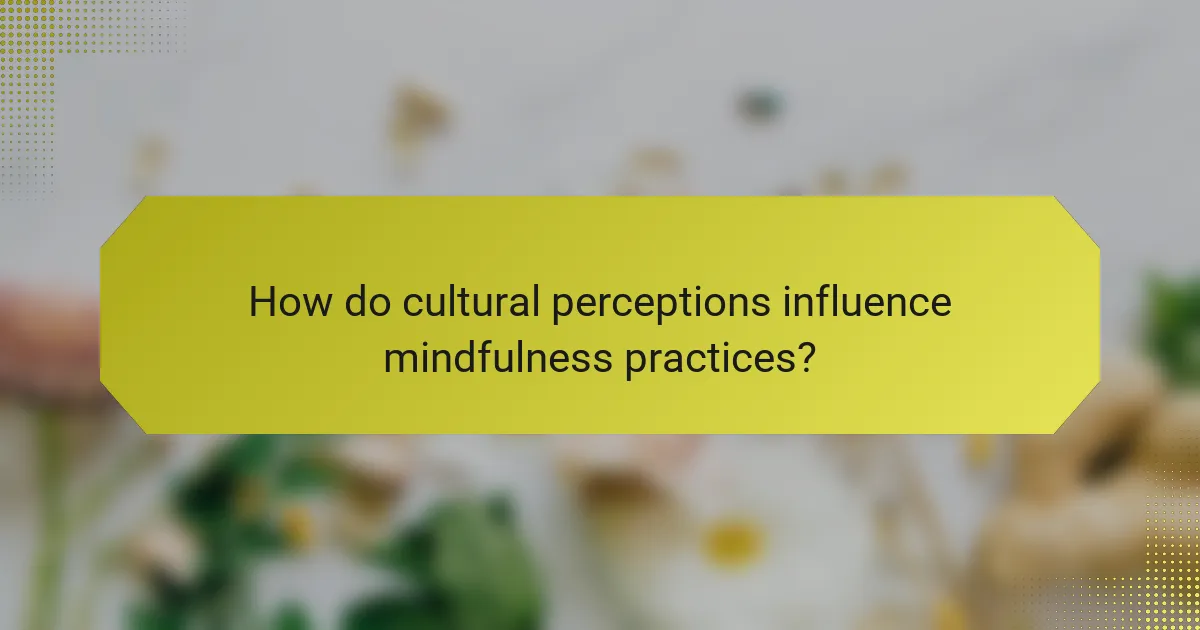
How do cultural perceptions influence mindfulness practices?
Cultural perceptions significantly shape mindfulness practices by influencing their adoption and adaptation. Different cultures interpret mindfulness through unique lenses, affecting techniques and outcomes. For instance, Eastern traditions often emphasize meditation as a path to enlightenment, while Western approaches may focus on stress reduction and emotional regulation. These cultural contexts determine the practices individuals find most relatable and effective. As a result, mindfulness techniques can vary widely, reflecting local values, beliefs, and societal norms.
What mindfulness techniques are popular in different regions?
Mindfulness techniques vary widely across regions, each offering unique approaches to stress reduction and emotional balance. In Asia, meditation practices like Zen and Vipassana focus on breath awareness and present-moment attention. In North America, mindfulness-based stress reduction (MBSR) combines meditation with yoga to enhance well-being. European practices often incorporate nature walks and forest bathing, emphasizing connection with the environment. In Africa, community rituals and storytelling foster collective mindfulness and emotional resilience. Each technique reflects cultural values, enhancing its effectiveness in promoting mental health.
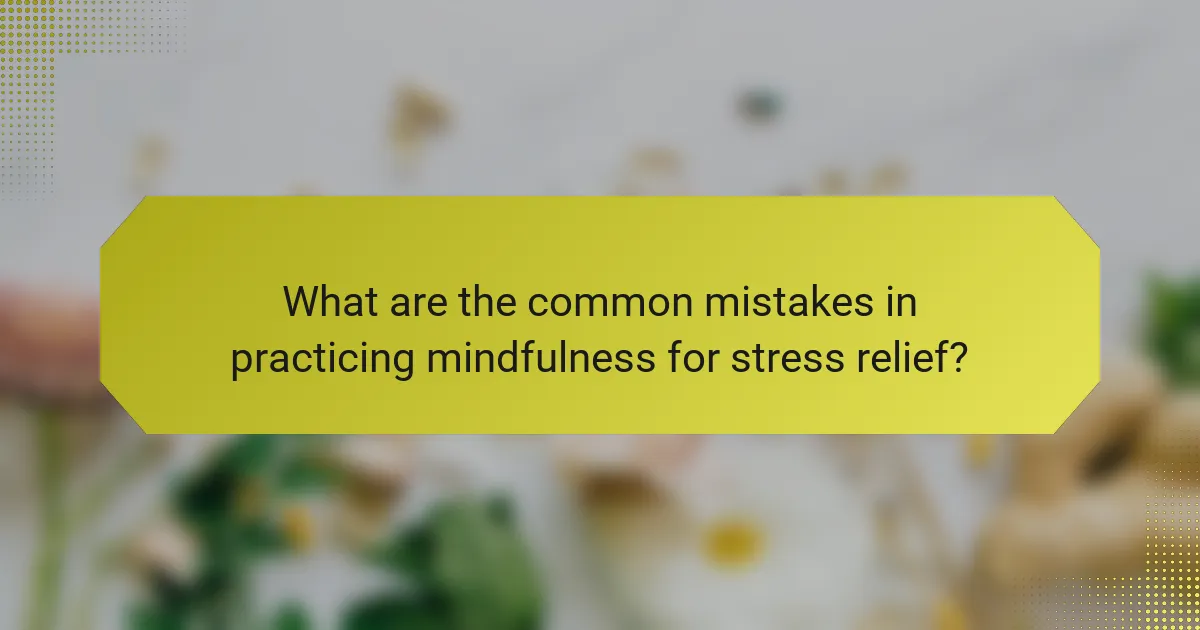
What are the common mistakes in practicing mindfulness for stress relief?
Common mistakes in practicing mindfulness for stress relief include overthinking, unrealistic expectations, and neglecting consistency. Many practitioners expect immediate results, leading to frustration. Skipping regular practice reduces effectiveness, as mindfulness requires habit formation. Additionally, focusing too much on technique can detract from the essence of being present. Lastly, failing to create a comfortable environment may hinder relaxation and focus.
How can one optimize their mindfulness practice for better results?
To optimize mindfulness practice for better results, incorporate structured techniques that enhance focus and emotional balance. Start by establishing a consistent routine, dedicating specific times for practice. Use guided meditations to deepen awareness and reduce stress. Incorporate breath control exercises to anchor attention and promote relaxation. Experiment with different forms of mindfulness, such as mindful walking or eating, to find what resonates. Tracking progress in a journal can provide insights into emotional changes and stress levels, reinforcing commitment to the practice.
What steps can be taken to create a consistent mindfulness routine?
To create a consistent mindfulness routine, establish a daily practice that includes specific techniques. Start with setting aside a dedicated time each day for mindfulness activities, such as meditation or deep breathing exercises. Incorporate mindful movement, like yoga or walking, to enhance physical awareness. Use guided sessions or apps to maintain engagement and provide structure. Track your progress to reinforce commitment and adjust techniques as needed for personal effectiveness. Aim for gradual increases in duration and complexity to deepen practice over time.
How can mindfulness be integrated into daily life for emotional balance?
Mindfulness can be integrated into daily life through simple practices that promote emotional balance. Start by setting aside a few minutes each day for mindful breathing. Focus on your breath to anchor yourself in the present moment.
Incorporate mindfulness during routine activities, such as eating or walking. Pay attention to the sensations and experiences involved, enhancing your awareness. Use guided meditations or mindfulness apps to establish a consistent practice.
Engage in reflective journaling to process emotions and thoughts. This technique allows for deeper self-understanding and emotional regulation.
Lastly, practice gratitude regularly. Acknowledging positive experiences fosters a balanced emotional state, contributing to overall well-being.
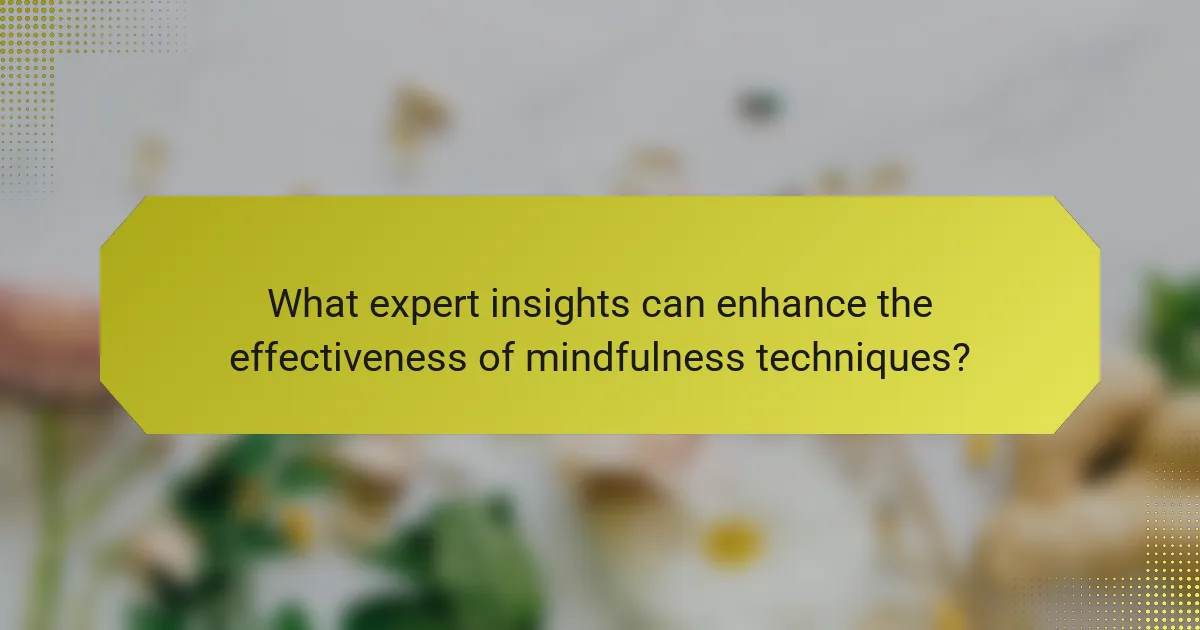
What expert insights can enhance the effectiveness of mindfulness techniques?
Expert insights can significantly enhance mindfulness techniques by incorporating evidence-based practices. For instance, integrating breathing exercises with mindfulness can improve emotional regulation. Research shows that consistent practice leads to a 30% reduction in stress levels. Utilizing guided meditations tailored for specific emotions can provide unique benefits, fostering deeper connections with one’s feelings. Additionally, exploring the role of gratitude in mindfulness can yield rare insights, as studies indicate it enhances overall well-being by promoting positive emotional states.
What are the best practices for beginners in mindfulness?
To effectively practice mindfulness, beginners should focus on simple techniques that promote stress reduction and emotional balance. Start with daily meditation, even if just for a few minutes, to cultivate awareness. Incorporate mindful breathing exercises to anchor attention and reduce anxiety. Engage in body scans to enhance connection with physical sensations. Regularly practice gratitude to foster positive emotions. Lastly, maintain a non-judgmental attitude towards thoughts and feelings, allowing for emotional balance.
How can feedback from mindfulness instructors improve practice?
Feedback from mindfulness instructors enhances practice by providing tailored guidance, fostering accountability, and identifying areas for improvement. Instructors can offer personalized insights that help practitioners refine techniques, leading to deeper emotional balance. Regular feedback sessions promote a growth mindset, encouraging individuals to explore mindfulness more deeply. This iterative process cultivates resilience against stress, ultimately enhancing overall well-being.
